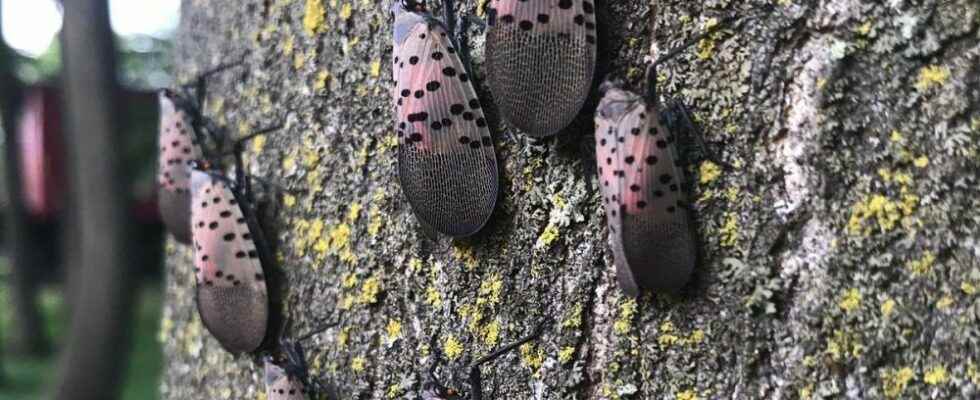The spotted lanternfly may be beautiful, with its uniquely colored wings. But don’t let this tiny creature fool you — it’s not one to befriend.

The spotted lanternfly may be beautiful, with its uniquely colored wings.
But don’t let this tiny creature fool you — it’s not one to befriend.
“They are quite attractive. They’re black, white, red and yellow,” said Amanda Roe, an adjunct biology professor at Western University in London and research scientist with Natural Resources Canada studying how the spotted lanternfly responds to cold and winter temperatures.
“But have you ever parked your car under a tree in the summer, and it gets covered in sticky stuff? These things do that, but imagine thousands of them, and they’re big,” she said.
Native to China and Southeast Asia, the spotted lanternfly (Lycorma delicatula) first appeared in Pennsylvania in 2014 and has since spread to 14 American states. The insects feed on more than 100 trees and plants, damaging them through their feeding and poop, otherwise known as honeydew or what Roe refers to as “sticky stuff.” That excrement can also promote the growth of mould.
Not only are spotted lanternflies a nuisance to ordinary people, but the invasive species has also wreaked havoc on vineyards and fruit orchards across the United States.
And it’s only a matter of time, experts warn, before the insect arrives in Canada, a circumstance that could spell disaster for growers in Southwestern Ontario and beyond.
“So far, it has not been established in Canada,” Roe said. “But we have detected them as close as Buffalo, NY, and also in Michigan, so they are literally on the doorstep.”

Early stages of the insect primarily target grapevines and fruit trees but also feed on maple, pine, oak, walnut and poplar. Adult lanternflies most often snack on tree of heaven, another non-native species becoming more widespread in Southern Ontario.
In parts of the US, spotted lanternfly infestations have caused the most damage to grapevines. “They can reduce yield by up to 90 per cent, and you can see the mortality of the vines themselves,” Roe said.
In 2019, an infestation in Pennsylvania cost the state an estimated 484 jobs and $50.1 million and was predicted to drain the economy at least $324 million each year if not contained, according to a study out of Penn State University.
Millions of dollars and several years of work have gone into making Ontario’s grape and wine industry resilient to Canada’s colder temperatures, “so the loss of that resource would be devastating,” Roe said.
Ontario’s grape and wine industry is concentrated in the province’s three designated viticultural areas: Niagara Peninsula, Lake Erie North Shore, and Prince Edward County. There are more than 1,400 vineyards in Southwestern Ontario, along the north shore of Lake Erie, according to Grape Growers of Ontario.
The looming invasion of the spotted lanternfly into Canada poses “a massive potential problem,” said Debbie Zimmerman, chief executive of Grape Growers of Ontario, an umbrella group representing more than 500 grape growers.
“It is quite concerning because we don’t have anything yet on how to manage it,” she said, noting the organization is working with the federal Canadian Food Inspection Agency and Ontario’s Ministry of Agriculture, Food and Rural Affairs to develop solutions.
The insects could wipe out entire vineyards, each one costing up to $40,000, Zimmerman said.
Nymphs and adults, which measure about an inch (2.5 centimeters) in length, are experts at traveling long distances by latching onto vehicles, Roe said.
“These guys are really good at hitchhiking,” she said. Their eggs are laid on surfaces like cars and can stick around throughout the winter before hatching wherever they wind up come spring.
In fact, in 2020, two dead spotted lanternfly adults were found in Quebec on trucks traveling from Pennsylvania, said Emily Posteraro, program development co-ordinator for the Invasive Species Centre, a national non-profit based in
Sault Ste. Mary, Ont
Still, she cautioned, “that doesn’t count as a detection because they were not alive.”
The Canadian Food Inspection Agency is working on a response plan for when the spotted lanternfly is discovered, Posteraro said.
With no natural predators and no organic pesticides to shut them down, experts stress public awareness about the spotted lanternfly as the most effective tool to prevent further spread.
“The biggest partner is actually the general public because we can’t be everywhere,” Roe said, referring to the agencies and researchers working to prevent the spread.
“The general public will probably be the one who finds the spotted lanternfly first because they are the ones who are outside,” she said.
The larvae and the adults are easier to spot because they’re distinct from other insects, but the eggs are trickier to find. “Those are really hard to see because they look like a great old piece of chewing gum (on) some smooth surface.”
The Local Journalism Initiative is funded by the Government of Canada
